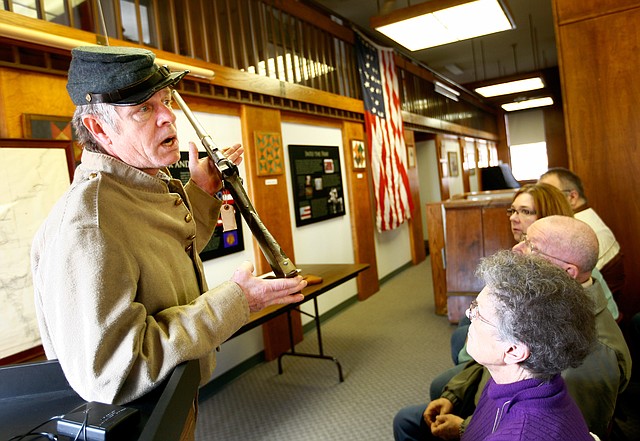Civil War Program Sheds Light On Lost History
STAFF PHOTO JASON IVESTER Doug Kidd of Tontitown details various Civil War weaponry during a presentation on Satuday, Feb. 16, 2013, inside the Rogers Histrorical Museum Education Annex. Kidd and Paul Dolle (cq) jointly delivered a presentation called Civil War Secrets of Osage Springs for about 50 in attendance.
Sunday, February 17, 2013
BENTONVILLE — As cars speed along Interstate 540 near Pinnacle Hills, few drivers realize the long history behind the land around them. What is now a center of commerce in Northwest Arkansas was an important base for troops during the Civil War, experts told guests at the Rogers Historical Museum on Saturday.
At A Glance
Sesquicentennial Events
The Civil War Secrets of Osage Springs was sanctioned by the Arkansas Civil War Sesquicentennial Commission. The commission promotes observance of the 150th anniversary of the Civil War in Arkansas. Events sanctioned by the commission range from 2012 to 2015.
Source: www.arkansascivilwar150.com
The museum hosted “Civil War Secrets of Osage Springs,” an all-day event that featured lectures and a re-enactment at the museum’s education annex. Paul Dolle of Rogers talked about the intrigue and danger surrounding Confederate guerrilla Buck Brown, and Doug Kidd enacted the scene of a soldier scavenging through haversacks on the battlefield.
Historic Osage Springs is located off New Hope Road in Rogers near the Olive Garden restaurant, said historian Monte Harris with the museum.
“It was very important through the ages — from the prehistoric Indian times into the Civil War times and even today, but for different reasons,” Harris said.
The spring was an important water source in the region, producing millions of gallons of water each day, according to the museum’s website. Ample fresh water drew troops from both sides during the Civil War.
William Martin “Buck” Brown was a prosperous farmer and miller in southeast Benton County before the war started, Dolle said. His mill was one of several that were burned by Union soldiers to get payback at bushwhackers for disrupting Union activities.
Large battles raged in Northwest Arkansas early in the Civil War, but the latter part of the war came down to small skirmishes between a Union contingent based in Fayetteville and bands of Confederates like Brown’s group.
“He was the number one Confederate guerrilla in Northwest Arkansas, at times commanding as many as 1,200 men,” Dolle said. “When you read the official federal records of the Civil War, he is mentioned time after time after time. He was a real nemesis of the Union army.”
Brown and his cohorts were determined to wreak havoc on the Union Army by attacking supply lines and tearing down telegraph wires to disrupt communication.
The loose organization of men was sanctioned by the Confederate Army under the Partisan Ranger Act, which allowed anyone who could raise a company of cavalry to be commissioned as a captain.
“There were some people in the Confederate government that had a lot of reservations as to the wisdom of just basically turning this loose because they would have very little control over what these guys were doing,” Dolle said.
Brown and his men often based their operations from Osage Springs during the war, Harris said. The low hill along Osage Springs made it an ideal location to hide while watching for enemies, Harris said. Like today, the road from Bentonville to Fayetteville passed by the spring.
Brown was a thorn in the side of the Union Army until he was finally killed by federal troops in March 1865.
After the Civil War, the springs were the setting for a trout farm and later a restaurant. Stacey Tarr’s family owned the property in the 1970s. Harris said Tarr has helped the museum fill in the post-Civil War history of the property.
“We’re getting ready to put a historical marker at Osage Springs with the Arkansas Sesquicentennial Commission to mark this because the history is fading so fast,” Harris said.
